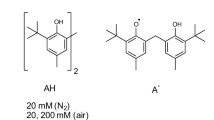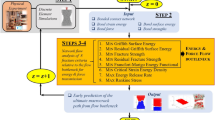Abstract
Fujiyabu et al. [1] experimentally reported that mixing of 3-arm star prepolymers into 4-arm analogs improves the toughness of the resultant polymer networks compared to that of the base network composed of only 4-arm star polymers. The present study investigated the mechanism of this phenomenon based on phantom chain simulations for polymer networks consisting of mixtures of star branch prepolymers with equal arm length and different arm numbers, \(\left({f}_{1},{f}_{2}\right)=\left({{{{\mathrm{3,4}}}}}\right)\), \(\left({{{{\mathrm{3,6}}}}}\right)\) and \(\left({{{{\mathrm{3,8}}}}}\right)\), for various \({f}_{1}=3\) prepolymer fractions \({\varphi }_{3}\). These networks were created via end-linking reactions between prepolymers traced by a Brownian dynamics scheme, and the network structure was stored at different conversion ratios \({\varphi }_{c}\), ranging from 0.6 to 0.9. The cycle rank of the gelated networks \(\xi\) is entirely consistent with that given by mean-field theory, demonstrating that the examined network structure is statistically valid. The networks were stretched with energy minimization until the break, and fracture characteristics including strain at break \({\varepsilon }_{b}\), stress at break \({\sigma }_{b}\), work for fracture \({W}_{b}\), and the ratio of broken strands \({\varphi }_{{bb}}\), were obtained. Plots of \({\varepsilon }_{b}\), \({\sigma }_{b}/{\varphi }_{{bb}}\), and \({W}_{b}/{\varphi }_{{bb}}\) versus \(\xi\) roughly follow the master curves reported for the base networks without mixing, implying that the change of fracture properties by the mixing of \({f}_{1}=3\) mainly corresponds to a decrease in \(\xi\). The mixing slightly suppresses \({\sigma }_{b}/{\varphi }_{{bb}}\) and \({W}_{b}/{\varphi }_{{bb}}\) for large \({f}_{2}\) cases compared to the base networks because of a biased breakage at the network strands without extenders, which are prepolymers with only two reacted arms. The analysis also revealed a new master curve for the \(\xi\)-dependence of the molecular weight of broken strands.
This is a preview of subscription content, access via your institution
Access options
Subscribe to this journal
Receive 12 print issues and online access
$259.00 per year
only $21.58 per issue
Buy this article
- Purchase on Springer Link
- Instant access to full article PDF
Prices may be subject to local taxes which are calculated during checkout








Similar content being viewed by others
References
Fujiyabu T, Sakumichi N, Katashima T, Liu C, Mayumi K, Chung U, et al. Tri-branched gels: rubbery materials with the lowest branching factor approach the ideal elastic limit. Sci Adv. 2022;8:abk0010_1–abk0010_10.
Fu J. Strong and tough hydrogels crosslinked by multi-functional polymer colloids. J Polym Sci B Polym Phys. 2018;56:1336–50.
Duan X, Sheardown H. Dendrimer crosslinked collagen as a corneal tissue engineering scaffOld: mechanical properties and corneal epithelial cell interactions. Biomaterials. 2006;27:4608–17.
Wang Q, Mynar JL, Yoshida M, Lee E, Lee M, Okuro K, et al. High-water-content mouldable hydrogels by mixing clay and a dendritic molecular binder. Nature. 2010;463:339–43.
Sun YN, Gao GR, Du GL, Cheng YJ, Fu J. Super tough, ultrastretchable, and thermoresponsive hydrogels with functionalized triblock copolymer micelles as macro-cross-linkers. ACS Macro Lett. 2014;3:496–500.
Masubuchi Y, Doi Y, Ishida T, Sakumichi N, Sakai T, Mayumi K, et al. Phantom-Chain simulations for the effect of node functionality on the fracture of star-polymer networks. Macromolecules. 2023. https://doi.org/10.1021/acs.macromol.3c01291.
Masubuchi Y. Phantom chain simulations for the effect of stoichiometry on the fracture of star-polymer networks. 2023;56:9359–67.
Masubuchi Y, Doi Y, Ishida T, Sakumichi N, Sakai T, Mayumi K, et al. Phantom chain simulations for the fracture of energy-minimized tetra- and tri-branched networks. Macromolecules. 2023;56:2217–23.
Sakai T. Gelation mechanism and mechanical properties of Tetra-PEG gel. React Funct Polym. 2013;73:898–903.
Ishikawa S, Iwanaga Y, Uneyama T, Li X, Hojo H, Fujinaga I, et al. Percolation-induced gel–gel phase separation in a dilute polymer network. Nat Mater. 2023;22:1564–70.
Honeycutt RL. Stochastic Runge-Kutta algorithms. I. White noise. Phys Rev A (Coll Park). 1992;45:600–3.
Sakai T. Gelation process and mechanical properties of polymer gels with well-defined network structure. Nihon Reoroji Gakkaishi. 2019;47:183–95.
Sakai T, Matsunaga T, Yamamoto Y, Ito C, Yoshida R, Suzuki S, et al. Design and fabrication of a high-strength hydrogel with ideally homogeneous network structure from tetrahedron-like macromonomers. Macromolecules. 2008;41:5379–84.
Panyukov S. Loops in polymer networks. Macromolecules. 2019;52:4145–53.
Zhong M, Wang R, Kawamoto K, Olsen BD, Johnson JA. Quantifying the impact of molecular defects on polymer network elasticity. Science. 2016;353:1264–8.
Shibayama M, Li X, Sakai T. Precision polymer network science with tetra-PEG gels—a decade history and future. Colloid Polym Sci. 2019;297:1–12.
Nocedal J. Updating quasi-newton matrices with limited storage. Math Comput. 1980;35:773.
Tsige M, Stevens MJ. Effect of cross-linker functionality on the adhesion of highly cross-linked polymer networks: a molecular dynamics study of epoxies. Macromolecules. 2004;37:630–7.
Tsige M, Lorenz CD, Stevens MJ. Role of network connectivity on the mechanical properties of highly cross-linked polymers. Macromolecules. 2004;37:8466–72.
Lang M, Müller T. Analysis of the gel point of polymer model networks by computer simulations. Macromolecules. 2020;53:498–512.
Masubuchi Y, Yamazaki R, Doi Y, Uneyama T, Sakumichi N, Sakai T. Brownian simulations for tetra-gel-type phantom networks composed of prepolymers with bidisperse arm length. Soft Matter. 2022;18:4715–24.
Nishi K, Chijiishi M, Katsumoto Y, Nakao T, Fujii K, Chung U, et al. Rubber elasticity for incomplete polymer networks. J Chem Phys. 2012;137:224903.
Nishi K, Noguchi H, Sakai T, Shibayama M. Rubber elasticity for percolation network consisting of Gaussian chains. J Chem Phys. 2015;143:184905.
Lei J, Li Z, Xu S, Liu Z. A mesoscopic network mechanics method to reproduce the large deformation and fracture process of cross-linked elastomers. J Mech Phys Solids. 2021;156:104599.
James H, Guth E. Simple presentation of network theory of rubber, with a discussion of other theories. J Polym Sci 1949;4:153–82.
Sakai T. Physics of polymer gels. 2020. Wiley. https://doi.org/10.1002/9783527346547.
Case LC. Branching in polymers. I. Network defects. J Polym Sci. 1960;45:397–404.
Scanlan J. The effect of network flaws on the elastic properties of vulcanizates. J Polym Sci. 1960;43:501–8.
Macosko CW, Miller DR. A new derivation of average molecular weights of nonlinear polymers. Macromolecules. 1976;9:199–206.
Macosko CW, Miller DR. Calculation of average molecular properties during nonlinear, living copolymerization. Makromol Chem 1991;192:377–404.
Yoshikawa Y, Sakumichi N, Chung U, Sakai T. Connectivity dependence of gelation and elasticity in AB-type polymerization: an experimental comparison of the dynamic process and stoichiometrically imbalanced mixing. Soft Matter. 2019;15:5017–25.
Acknowledgements
This study is partly supported by JST-CREST (JPMJCR1992) and JSPS KAKENHI (22H01189).
Author information
Authors and Affiliations
Corresponding author
Ethics declarations
Conflict of interest
The author declares no competing interests.
Additional information
Publisher’s note Springer Nature remains neutral with regard to jurisdictional claims in published maps and institutional affiliations.
Rights and permissions
Springer Nature or its licensor (e.g. a society or other partner) holds exclusive rights to this article under a publishing agreement with the author(s) or other rightsholder(s); author self-archiving of the accepted manuscript version of this article is solely governed by the terms of such publishing agreement and applicable law.
About this article
Cite this article
Masubuchi, Y. Phantom chain simulations for fracture of polymer networks created from star polymer mixtures of different functionalities. Polym J 56, 163–171 (2024). https://doi.org/10.1038/s41428-023-00862-w
Received:
Revised:
Accepted:
Published:
Issue Date:
DOI: https://doi.org/10.1038/s41428-023-00862-w



